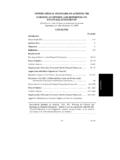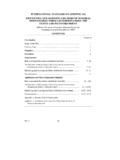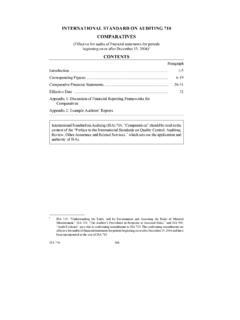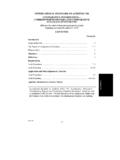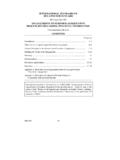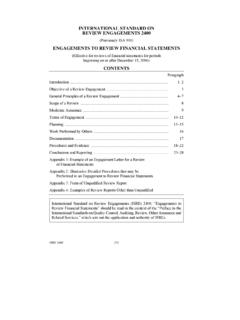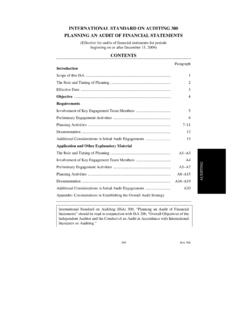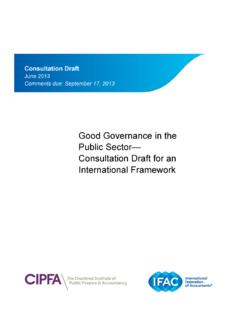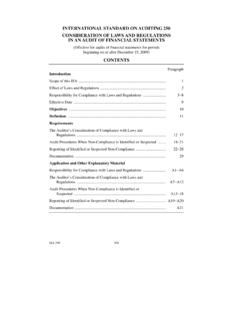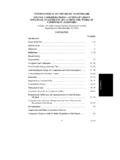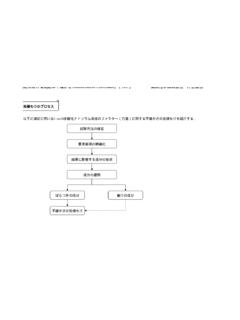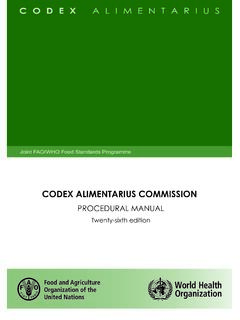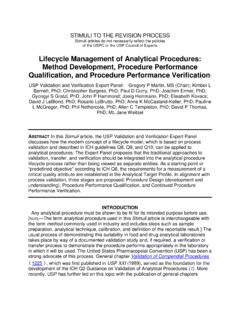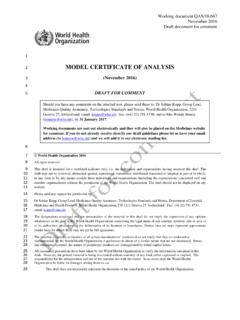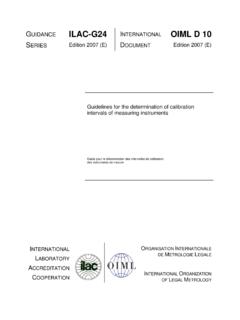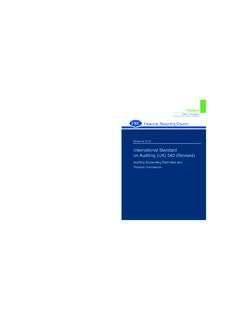Transcription of ISA 540 (Revised) and Conforming and Consequential ...
1 Final Pronouncement October 2018. International Standard on Auditing 540 (Revised). ISA 540 (Revised). and Conforming and Consequential Amendments to Other International Standards Arising from ISA 540 (Revised). About the IAASB. This document was developed and approved by the International Auditing and Assurance Standards Board. The objective of the IAASB is to serve the public interest by setting high-quality auditing, assurance, and other related standards and by facilitating the convergence of international and national auditing and assurance standards, thereby enhancing the quality and consistency of practice throughout the world and strengthening public confidence in the global auditing and assurance profession. The IAASB develops auditing and assurance standards and guidance for use by all professional accountants under a shared standard-setting process involving the Public Interest Oversight Board, which oversees the activities of the IAASB, and the IAASB Consultative Advisory Group, which provides public interest input into the development of the standards and guidance.
2 The structures and processes that support the operations of the IAASB are facilitated by the International Federation of Accountants (IFAC). For copyright, trademark, and permissions information, please see page 94. CONTENTS. Page ISA 540 (Revised). Auditing Accounting Estimates and Related Disclosures . 4. Conforming and Consequential Amendments to Other International Standards .. 62. 3. INTERNATIONAL STANDARD ON AUDITING 540 (REVISED). AUDITING ACCOUNTING ESTIMATES AND RELATED DISCLOSURES. (Effective for audits of financial statements for periods beginning on or after December 15, 2019). CONTENTS. Paragraph Introduction Scope of this ISA .. 1. Nature of Accounting Estimates .. 2 3. Key Concepts of This ISA .. 4 9. Effective Date .. 10. Objective .. 11. 12. Requirements Risk Assessment Procedures and Related Activities.
3 13 15. Identifying and Assessing the Risks of Material Misstatement .. 16 17. Responses to the Assessed Risks of Material Misstatement .. 18 30. Disclosures Related to Accounting Estimates .. 31. Indicators of Possible Management 32. Overall Evaluation Based on Audit Procedures Performed .. 33 36. Written Representations .. 37. Communication with Those Charged With Governance, Management, or Other Relevant 38. Documentation .. 39. Application and Other Explanatory Material Nature of Accounting Estimates .. A1 A7. Key Concepts of This ISA .. A8 A13. Definitions .. A14 A18. Risk Assessment Procedures and Related Activities .. A19 A63. Identifying and Assessing the Risks of Material Misstatement .. A64 A80. Responses to the Assessed Risks of Material Misstatement .. A81 A132. Indicators of Possible Management A133 A136.
4 4. ISA 540 (REVISED). Overall Evaluation Based on Audit Procedures Performed .. A137 A144. Written Representations .. A145. Communication with Those Charged With Governance, Management or Other Relevant A146 A148. Documentation .. A149 A152. Appendix 1: Inherent Risk Factors Appendix 2: Communications with Those Charged with Governance International Standard on Auditing (ISA) 540 (Revised), Auditing Accounting Estimates and Related Disclosures, should be read in conjunction with ISA 200, Overall Objectives of the Independent Auditor and the Conduct of an Audit in Accordance with International Standards on Auditing. ISA 540 (Revised) has received the approval of the Public Interest Oversight Board (PIOB), which concluded that due process was followed in the development of the standard and that proper regard was paid to the public interest.
5 5. ISA 540 (REVISED). Introduction Scope of this ISA. 1. This International Standard on Auditing (ISA) deals with the auditor's responsibilities relating to accounting estimates and related disclosures in an audit of financial statements. Specifically, it includes requirements and guidance that refer to, or expand on, how ISA 315 (Revised),1 ISA 330,2. ISA 450, 3 ISA 5004 and other relevant ISAs are to be applied in relation to accounting estimates and related disclosures. It also includes requirements and guidance on the evaluation of misstatements of accounting estimates and related disclosures, and indicators of possible management bias. Nature of Accounting Estimates 2. Accounting estimates vary widely in nature and are required to be made by management when the monetary amounts cannot be directly observed. The measurement of these monetary amounts is subject to estimation uncertainty , which reflects inherent limitations in knowledge or data.
6 These limitations give rise to inherent subjectivity and variation in the measurement outcomes. The process of making accounting estimates involves selecting and applying a method using assumptions and data, which requires judgment by management and can give rise to complexity in measurement . The effects of complexity, subjectivity or other inherent risk factors on the measurement of these monetary amounts affects their susceptibility to misstatement. (Ref: Para. A1 A6, Appendix 1). 3. Although this ISA applies to all accounting estimates, the degree to which an accounting estimate is subject to estimation uncertainty will vary substantially. The nature, timing and extent of the risk assessment and further audit procedures required by this ISA will vary in relation to the estimation uncertainty and the assessment of the related risks of material misstatement.
7 For certain accounting estimates, estimation uncertainty may be very low, based on their nature, and the complexity and subjectivity involved in making them may also be very low. For such accounting estimates, the risk assessment procedures and further audit procedures required by this ISA would not be expected to be extensive. When estimation uncertainty , complexity or subjectivity are very high, such procedures would be expected to be much more extensive. This ISA contains guidance on how the requirements of this ISA can be scaled. (Ref: Para. A7). Key Concepts of This ISA. 4. This ISA requires a separate assessment of inherent risk for purposes of assessing the risks of material misstatement at the assertion level for accounting estimates. Depending on the nature of a particular accounting estimate, the susceptibility of an assertion to a misstatement that could be material may be subject to or affected by estimation uncertainty , complexity, subjectivity or other inherent risk factors, and the interrelationship among them.
8 As explained in ISA 200,5 inherent risk is higher for some assertions and related classes of transactions, account balances and disclosures 1. ISA 315 (Revised), Identifying and Assessing the Risks of Material Misstatement through Understanding the Entity and Its Environment 2. ISA 330, The Auditor's Responses to Assessed Risks 3. ISA 450, Evaluation of Misstatements Identified during the Audit 4. ISA 500, Audit Evidence 5. ISA 200, Overall Objectives of the Independent Auditor and the Conduct of an Audit in Accordance with International Standards on Auditing, paragraph A40. 6. ISA 540 (REVISED). than for others. Accordingly, the assessment of inherent risk depends on the degree to which the inherent risk factors affect the likelihood or magnitude of misstatement, and varies on a scale that is referred to in this ISA as the spectrum of inherent risk.
9 (Ref: Para. A8 A9, A65 A66, Appendix 1). 5. This ISA refers to relevant requirements in ISA 315 (Revised) and ISA 330, and provides related guidance, to emphasize the importance of the auditor's decisions about controls relating to accounting estimates, including decisions about whether: There are controls relevant to the audit, for which the auditor is required to evaluate their design and determine whether they have been implemented. To test the operating effectiveness of relevant controls. 6. This ISA also requires a separate assessment of control risk when assessing the risks of material misstatement at the assertion level for accounting estimates. In assessing control risk, the auditor takes into account whether the auditor's further audit procedures contemplate planned reliance on the operating effectiveness of controls.
10 If the auditor does not perform tests of controls, the auditor's assessment of the risk of material misstatement at the assertion level cannot be reduced for the effective operation of controls with respect to the particular assertion. 6 (Ref: Para. A10). 7. This ISA emphasizes that the auditor's further audit procedures (including, where appropriate, tests of controls) need to be responsive to the reasons for the assessed risks of material misstatement at the assertion level, taking into account the effect of one or more inherent risk factors and the auditor's assessment of control risk. 8. The exercise of professional skepticism in relation to accounting estimates is affected by the auditor's consideration of inherent risk factors, and its importance increases when accounting estimates are subject to a greater degree of estimation uncertainty or are affected to a greater degree by complexity, subjectivity or other inherent risk factors.
